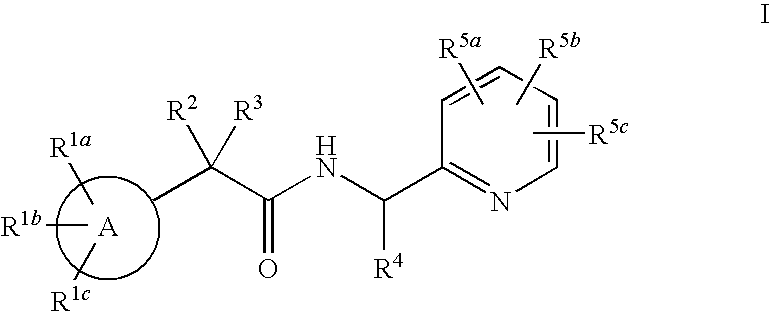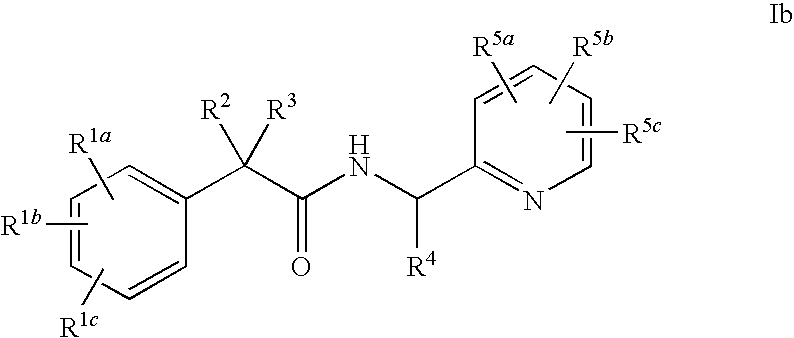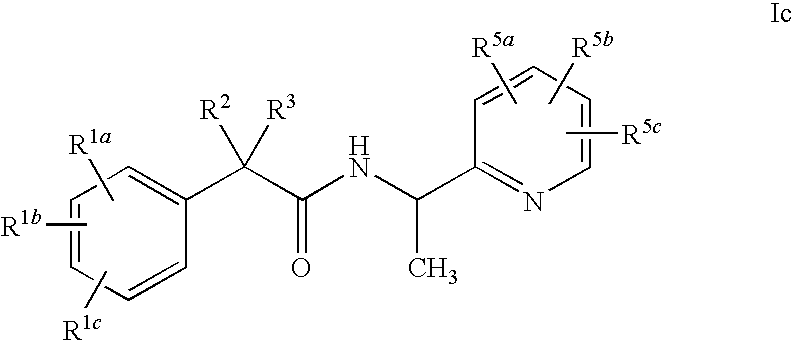Pyridyl amide T-type calcium channel antagonists
a calcium channel antagonist and pyridyl amide technology, applied in the field of voltage gated channel proteins, can solve the problems of numerous problems in the known therapeutic regimen for such diseases and disorders, and achieve the effect of treating or preventing
- Summary
- Abstract
- Description
- Claims
- Application Information
AI Technical Summary
Benefits of technology
Problems solved by technology
Method used
Image
Examples
example 1
[0368]
N-[(1R)-1-(5-bromopyridin-2-ylethyl]-2-[4-(5-methylisoxazol-4-yl)phenyl]acetamide
[0369]2-(acetoxymethyl)-5-bromopyridine: To a solution of 2-methyl-5-bromopyridine (40 g, 0.23 mol) in dichloromethane (500 ml) was added M-CPB A (64 g, 0.25 mol) in batches at 0° C. After stirring for 16 h at room temperature, the mixture was washed with sat. aq. NaHCO3, aq. NaHSO3 and brine successively. The organic layer was dried over MgSO4 and then concentrated to give 35 g, (79.2%) of 2-acetoxymethyl-5-bromopyridine as a yellow solid. A mixture of 35 g (0.19 mol) 2-acetoxymethyl-5-bromopyridine and Ac2O (160 ml) was heated to reflux for 1 hour. To this mixture was cautiously added 150 mL EtOH (until the excess AC20 was converted to EtOAc and AcOH). After concentration, the residue was neutralized with aq. KHCO3 and extracted with CH2Cl2. The extract was dried over MgSO4 and purified by silica gel chromatography to give 2-(acetoxymethyl)-5-bromopyridine. 1H-NMR (400 MHz, CDCl3) δ 8.65 (d, J=2...
example 2
[0375]
2-[4-(5-methylisoxazol-4-yl)phenyl]-N-[(1R)-1-(5-vinylpyridin-2-yl)ethyl]acetamide
[0376]To a solution of 0.18 g (0.46 mmol) N-[(1R)-1-(5-bromopyridin-2-yl)ethyl]-2-[4-(5-methylisoxazol-4-yl)phenyl]acetamide in 0.50 ml CH3CN and 0.50 ml water was added 0.07 g (0.46 mmol) 2-vinyl-4,4,5,5-tetramethyl-1,3,2-dioxaborolane, 0.02 g (0.03 mmol) TXPTS, 0.003 g (0.01 mmol) Palladium (II) acetate, and 0.13 mL (0.92 mmol) diisopropylamine. After 20 min in the microwave at 120° C., the reaction mixture was cooled, extracted with CH2Cl2, and washed with brine. The organic layer was dried over NaSO4, filtered, and concentrated in vacuo. Purification by flash chromatography (1×14 cm silica gel, linear gradient 40-85% EtOAc:hexane) afforded 2-[4-(5-methylisoxazol-4-yl)phenyl]-N-[(1R)-1-(5-vinylpyridin-2-yl)ethyl]acetamide. Electrospray mass spec M+H=348.1.
example 3
[0377]
N-[(1R)-1-(5-ethylpyridin-2-yl)ethyl]-2-[4-(5-methylisoxazol-4-yl)phenyl]acetamide
[0378]To a solution of 0.11 g (0.32 mmol) 2-[4-(5-methylisoxazol-4-yl)phenyl]-N-[(1R)-1-(5-vinylpyridin-2-yl)ethyl]acetamide in 1.30 ml EtOAc was added 0.010 g of 10% palladium on carbon. The reaction flask was equipped with a hydrogen balloon. After 24 h at room temperature, the reaction mixture was filter through celite, washed three times with methanol, and concentrated in vacuo. Purification by automated flash chromatography (40 g silica gel cartridge 20-100% EtAOc / hex over 15 min) afforded N-[(1R)-1-(5-ethylpyridin-2-yl)ethyl]-2-[4-(5-methylisoxazol-4-yl)phenyl]acetamide 1H NMR (CDCl3, 400 MHz) 8.35 (s, 1H); 8.31 (d, 1H, J=1.56 hz); 7.47 (dd, 1H, J=2.19 Hz, 7.96 Hz); 7.36 (d, 4H, J=2.29 Hz); 7.13 (d, 1H, J=7.88 Hz); 6.97 (br d, 1H J=7.88 Hz); 5.10 (m, 1H); 3.62 (s, 2H); 2.63 (q, 2H, J=7.60 Hz, 15.11 Hz); 2.57 (s, 3H); 1.43 (d, 3H, J=6.69); 1.24 (t, 3H, J=7.60). HRMS (ES) exact mass calcd for...
PUM
| Property | Measurement | Unit |
|---|---|---|
| tip diameter | aaaaa | aaaaa |
| series resistance | aaaaa | aaaaa |
| voltage | aaaaa | aaaaa |
Abstract
Description
Claims
Application Information
 Login to View More
Login to View More - R&D
- Intellectual Property
- Life Sciences
- Materials
- Tech Scout
- Unparalleled Data Quality
- Higher Quality Content
- 60% Fewer Hallucinations
Browse by: Latest US Patents, China's latest patents, Technical Efficacy Thesaurus, Application Domain, Technology Topic, Popular Technical Reports.
© 2025 PatSnap. All rights reserved.Legal|Privacy policy|Modern Slavery Act Transparency Statement|Sitemap|About US| Contact US: help@patsnap.com



